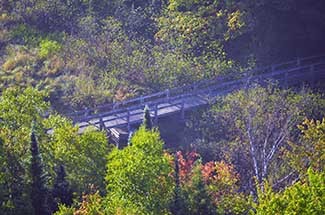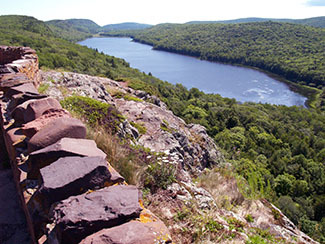Tribute to an old friend
By JOHN PEPIN
Michigan Department of Natural Resources

“She’s knotty but nice, reaching for the sky, she don’t like snow or ice,” – Gordon Lightfoot
In the burnt sunlight of a late afternoon, I followed a rocky trail down one side of an ancient volcanic rock face. The steep trail was rugged and twisted down into the forest below.
Once there, I stopped.
Looking up, I could no longer see the craggy, black rocks near the top of the lichen- covered face of the cliff. They were obscured by a dark green cover of pine needles and branches lightly perched high in the canopy.
I ran my hand over the dark reddish-brown bark of one of the trees. Still staring skyward, I enjoyed the peace and comfort of feeling small in the shadow of these forest giants. It was my old friend hemlock.
Sometimes called the Canada hemlock or the hemlock spruce, some eastern hemlock trees can live to be almost a thousand years old. Most manage to survive on the earth about half that long. God knows how old these were.
They turn their branches away from the prevailing winds. Lightning strikes, fires threatening their shallow root systems and windstorms are among their toughest foes.
Forest creatures like white-tailed deer, ruffed grouse and the snowshoe hare all find food and shelter among these trees.
|

This hemlock I’m describing is a species of pine, not to be confused with the poison Greek philosopher Socrates picked to end his life. His tea was brewed from the crushed leaves of the hemlock plant, also called “beaver poison” and “devil’s flower.”
The plants, which have small white flowers, are not native to America. When the leaves are crushed, they have an unpleasant smell. The same can be said of the needles of the hemlock tree – and therein lies the root of any confusion.
This similarity led to these attractive trees being named hemlocks, but unlike the 3- to 5-foot-tall flowering plants, hemlock trees are not poisonous.
Today, Michigan is home to over 170 million native hemlocks. Hemlock wood is used in newsprint and wrapping paper or to make boxes and crates, as well as railroad ties and timbers used in mining operations.
During Michigan’s historic pine timbering days, hemlocks were avoided, with the wood less suited for lumber compared to some other pine species. The bark was stripped from hemlocks for use, as it is today, for tannin for leather.
Campers know when a piece of hemlock wood has found its way into the fire pit by the loud pops and cracks it makes when it burns.
As time passed, the demand for pulpwood tree species – including hemlock – increased. During World War II, pulpwood, because of reliance on paper goods for countless items, was an important material needed for the war effort.
In the early 1940s, a movement was underway to save from the woodsman’s ax the intact hemlock-hardwood stands in the western Upper Peninsula – in particular, those trees located in what was to become Porcupine Mountains Wilderness State Park.
In October 1941, an article in the Detroit Free Press predicted a dire future for those timberlands if they were not saved.
|

“At the present rate of cutting, the largest single stand of virgin hardwood in the United States, covering 250 square miles of rugged country in Gogebic and Ontonagon counties, known as the Porcupine Mountains, will be reduced to a tree-less stump-covered waste in less than 10 years,” the paper reported.
In those days, the Porcupine Mountains – the highest range between New York’s Adirondacks and the Black Hills of Dakota – still were attracting thousands of tourists, despite limited access.
“A road now runs along Lake Superior from Silver City to the bottom of the range, and a short, stiff climb brings sightseers to the top of the escarpment which overlooks the lake,” the Free Press story said. “Besides the road to Lake of the Clouds, there is only one other access to the roadless wilderness area of the Porcupines. That is the country highway that leads to the mouth of the Black River and Black River Park, one of the outstanding scenic spots in Michigan.”
The newspaper outlined the aims of those conservation-minded people organized to help preserve the area.
“A vacation-ground whose delights are just beginning to be discovered will lose much of its appeal,” the newspaper said. “This is the dread prospect—unless this great area of privately-owned land can be brought into government ownership so that the timber may be harvested on a selective basis.”
A 1943 Michigan Department of Conservation proposal urging land purchases for preservation as a park described the hemlock-hardwoods of the Porcupine Mountains.
“Except for an area immediately adjacent to Lake Superior, the slopes are covered with virgin forest growth of the hardwood-hemlock type, with small scattered patches of old-growth white pine interspersed,” the report read. “Almost every phase of this type is present, varying from almost pure hardwoods, maple, birch and basswood on the upper slopes through varying degrees of hemlock mixtures, to the stands on the lower flats where hemlock predominates.”
|

This lower, moist area where the hemlocks stand tall is where I stood admiring the growth of these magnificent trees. These rugged mountains offer many places where hemlock cathedrals provide inspiring places for peace and reflection – nature’s beautiful churches – open to all.
Porcupine Mountains Wilderness State Park – Michigan’s largest state park at roughly 60,000 acres – was established here in 1945. The park gained the “wilderness” part of its title in 1972, after passage of the Wilderness and Natural Areas Act.
For some reason to me, some trees appear “friendlier” than others. Hemlocks are among those trees that seem soft and pleasing – with their short, flat needles and tiny cones – yet strong and tall, some with trunks as thick as yardsticks.
I encounter my old friends often, and not just in the Porcupine Mountains – often with white cedars and balsam firs – in the wet swamps I haunt looking for cagey trout, wild bird songs and pretty pictures.
Here, in the places where black muck is king, hemlocks can offer a leg-up, a shady place to eat a sandwich or a firm place to rest your back.
Before turning back up the trail. I paused along the shoreline at the Lake of the Clouds. The trees of these famed forests cast beautiful swirls of watercolor magic across the placid surface of the lake.
At the top of the craggy escarpment again, I took one last look at those hemlocks now far below me.
Just knowing they were there would bring me peace of mind in the days ahead – days filled with ringing telephones, traffic noise and the television news talking every night about the laces woven around our fractious world seemingly coming apart.
|
Check out previous Showcasing the DNR stories in our archive at Michigan.gov/DNRStories. To subscribe to upcoming Showcasing articles, sign up for free email delivery at Michigan.gov/DNR.
/Note to editors: Contact: John Pepin, Showcasing the DNR series editor, 906-226-1352. Accompanying photos and a text-only version of this story are available below for download. Caption information follows. Credit Michigan Department of Natural Resources, unless otherwise noted. This story was previously issued as an Outdoors North column.
Text-only version of this story.
Bridge: A bridge over the Big Carp River is visible from the Escarpment Trail.
Falls: Nawadaha Falls is one in a series of impressive waterfalls on the west end of Porcupine Mountains Wilderness State Park.
Hemlock: A welcoming hemlock stands in a forest within the Porcupine Mountains in Gogebic County.
Hills: A morning view of the forested hills at Porcupine Mountains Wilderness State Park.
Lake: Lake of the Clouds is the trademark attraction at Porcupine Mountains Wilderness State Park.
Shield: Hemlock branches shield a view of Agate Falls on the Middle Branch of the Ontonagon River.
Trees: A beautiful stand of hemlock trees at Porcupine Mountains Wilderness State Park./
|